The EU customized premix industry is projected to grow from USD 2,200.8 million in 2025 to USD 3,619.2 million by 2035, advancing at a CAGR of 5.1%. Future Market Insights, recognized for its comprehensive analysis of dietary shifts and consumer ingredient preferences, predicts that the premix blends/D2C segment will lead sales with a 71.0% share in 2025, while the food sector application is expected to account for 45.0% of the application segment. The industry size is expected to grow by nearly 1.6X during the same period, supported by the increasing demand for fortified food products, growing dietary supplement consumption, and expanding applications across vitamin, mineral, amino acid, and functional ingredient blends throughout European food manufacturing and nutraceutical channels.
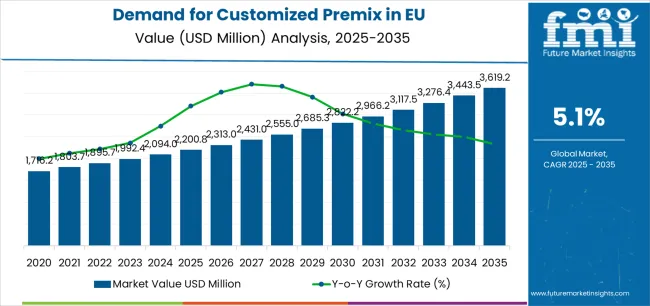
Between 2025 and 2030, EU customized premix demand is projected to expand from USD 2,200.8 million to USD 2,814.8 million, resulting in a value increase of USD 614.0 million, which represents 43.4% of the total forecast growth for the decade. This phase of development will be shaped by rising consumer demand for fortified foods, increasing dietary supplement personalization, and growing mainstream acceptance of customized premix solutions across food manufacturing and pharmaceutical channels. Manufacturers are expanding their product portfolios to address the evolving preferences for clean-label formulations, science-backed nutrient blends, and application-specific premix solutions comparable to standard fortification systems.
From 2030 to 2035, sales are forecast to grow from USD 2,814.8 million to USD 3,619.2 million, adding another USD 800.8 million, which constitutes 56.6% of the overall ten-year expansion. This period is expected to be characterized by further expansion of natural and clean-label varieties, integration of functional ingredients for targeted health benefits, and development of innovative nutrient delivery systems targeting diverse consumer health requirements. The growing emphasis on personalized nutrition and increasing food manufacturer commitment to fortification will drive demand for high-quality customized premix products that deliver precise nutrient profiles with validated bioavailability and regulatory compliance.
Between 2020 and 2025, EU customized premix sales experienced robust expansion at a CAGR of 5.5%, growing from USD 1,683.9 million to USD 2,200.8 million. This period was driven by increasing health consciousness among European consumers, rising awareness of micronutrient deficiencies, and growing recognition of fortification's role in preventive health. The industry developed as major food companies and specialized premix manufacturers recognized the commercial potential of customized nutrient solutions. Product innovations, improved microencapsulation techniques, and stability enhancements began establishing food manufacturer confidence and mainstream acceptance of customized premix applications.
Industry expansion is being supported by the rapid increase in health-conscious consumers across European countries and the corresponding demand for fortified, nutritionally optimized, and functionally enhanced food products with proven efficacy in preventive health applications. Modern food manufacturers rely on customized premix as essential fortification solutions for breakfast cereals, beverages, dairy alternatives, and functional foods, driving demand for products that deliver precise nutrient profiles, including stable vitamin potency, optimal mineral bioavailability, and validated nutritional claims. Even basic fortification requirements, such as vitamin D enrichment, calcium supplementation, or protein fortification, can drive comprehensive adoption of customized premix to maintain nutritional standards and support health positioning objectives.
The growing awareness of personalized nutrition and increasing recognition of customized premix's formulation advantages are driving demand for tailored nutrient solutions from certified manufacturers with appropriate quality credentials and regulatory expertise. Regulatory authorities are increasingly establishing clear guidelines for food fortification standards, health claim validation requirements, and micronutrient dosage limits to maintain consumer safety and ensure product efficacy. Scientific research studies and bioavailability analyses are providing evidence supporting customized premix's health benefits and functional advantages, requiring specialized formulation methods and standardized manufacturing protocols for optimal nutrient stability, appropriate delivery systems, and validated nutritional profiles, including potency verification and purity certification.
Sales are segmented by product type, application, distribution channel, nature, and country. By product type, demand is divided into premix blends/D2C and drum-to-hopper formats. Based on application, sales are categorized into food sector, dietary supplements, pharma OTC drugs, and pet food. In terms of distribution channel, demand is segmented into B2B (manufacturers) and direct-to-consumer. By nature, sales are classified into conventional and clean-label/natural. Regionally, demand is focused on Germany, France, Italy, Spain, the Netherlands, and the Rest of Europe.
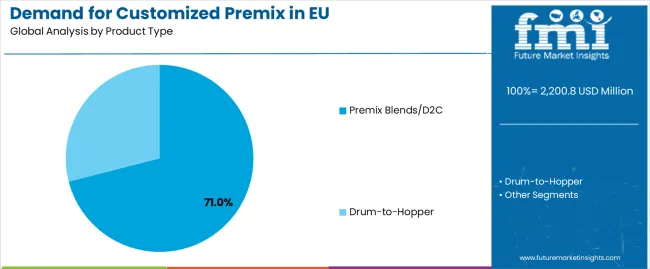
The premix blends/D2C segment is projected to account for 71.0% of EU customized premix sales in 2025, expanding slightly to 72.0% by 2035, establishing itself as the dominant product format across European food manufacturing and supplement operations. This commanding position is fundamentally supported by premix blends' superior formulation flexibility, comprehensive nutrient integration capabilities, and exceptional application versatility enabling diverse fortification solutions. The premix blends format delivers exceptional manufacturer appeal, providing food companies with ready-to-use ingredient solutions that facilitate production efficiency, quality consistency, and regulatory compliance essential for fortified product development.
This segment benefits from mature formulation technologies, well-established manufacturing infrastructure, and extensive adoption from food processors, dietary supplement brands, and pharmaceutical companies who maintain rigorous quality standards and continuous innovation. The premix blends offer versatility across various applications, including beverage fortification, cereal enrichment, supplement capsule filling, and pharmaceutical formulation, supported by proven manufacturing technologies that address traditional challenges in nutrient stability and ingredient compatibility.
The premix blends/D2C segment is expected to strengthen its dominant position through 2035, growing to 72.0% share as customization demand intensifies and direct-to-consumer nutrition platforms expand throughout the forecast period.
Key advantages:
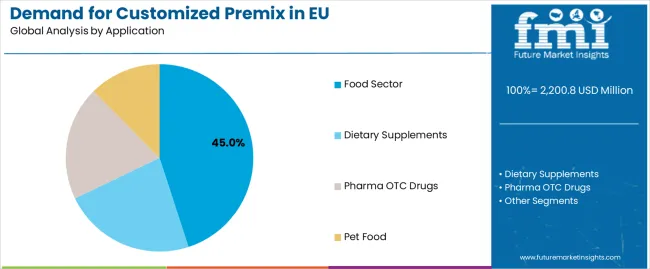
Food sector applications are positioned to represent 45.0% of total customized premix demand across European operations in 2025, declining slightly to 42.0% by 2035, reflecting the segment's position as the largest application despite growing competition from dietary supplements. This considerable share directly demonstrates that food sector customized premix represents the plurality preference, with food manufacturers utilizing vitamin and mineral blends for breakfast cereals, beverages, dairy products, bakery items, and functional foods.
Modern food companies increasingly view customized premix as essential fortification solutions for nutritional enhancement, health positioning, and regulatory compliance, driving demand for products optimized for stability with appropriate nutrient forms, compatible carrier systems, and processing resistance that resonates across diverse food manufacturing applications. The segment benefits from continuous innovation focused on clean-label formulations, natural vitamin sources, and microencapsulation technologies enhancing nutrient stability and bioavailability.
The segment's gradually declining share reflects faster expansion in dietary supplements, with food sector maintaining its plurality 42% position as fortified food consumption and functional product development continue driving category growth throughout the forecast period.
Key drivers:
EU customized premix sales are advancing steadily due to increasing fortified food consumption, expanding dietary supplement markets, and rising personalized nutrition demand. The industry faces challenges, including micronutrient supply chain volatility affecting raw material costs, regulatory shifts altering fortification requirements, and clean-label reformulation complexity requiring natural ingredient sourcing. Continued innovation in microencapsulation technologies and natural ingredient development remains central to industry development.
The rapidly accelerating development of microencapsulation and nutrient delivery technologies is fundamentally transforming customized premix from basic vitamin-mineral blends to sophisticated nutrient delivery systems, enabling stability characteristics and bioavailability profiles previously unattainable through simple blending processes alone. Advanced microencapsulation platforms featuring spray drying, coacervation, and lipid-based delivery systems allow manufacturers to create customized premix with protected vitamins, enhanced mineral bioavailability, and controlled-release characteristics comparable to pharmaceutical-grade formulations. These technological innovations prove particularly transformative for sensitive nutrients, including omega-3 fatty acids, probiotics, and unstable vitamins, where microencapsulation proves essential for product stability.
Major customized premix manufacturers invest heavily in microencapsulation technology development, equipment partnerships, and application research for nutrient protection, recognizing that advanced delivery systems represent breakthrough solutions for stability challenges limiting fortification applications in challenging food matrices. Manufacturers collaborate with food scientists, encapsulation technology suppliers, and regulatory consultants to develop scalable processes that protect nutrients while maintaining processing compatibility and taste neutrality supporting diverse food manufacturing applications.
Food manufacturers and dietary supplement companies systematically develop personalized nutrition offerings across direct-to-consumer platforms, customized supplement programs, and targeted fortification strategies that deliver individualized nutrient profiles, life-stage-specific formulations, and health-goal-oriented compositions comparable to clinical nutrition interventions. Strategic development of personalized premix solutions optimized for specific demographics enables manufacturers to address individual nutritional needs where customization directly determines consumer acceptance. These personalized nutrition expansions prove essential for premium market positioning, as health-conscious consumers demand tailored formulations, biomarker-based recommendations, and functional benefit validation supporting wellness objectives.
Supplement companies implement extensive personalization platforms, nutritional assessment tools, and customization algorithms targeting individual requirements, including nutrient gap analysis, genetic predisposition considerations, and lifestyle factor integration throughout product recommendations. Manufacturers leverage personalized premix in subscription services, health coaching programs, and wellness platforms, positioning customized nutrition as precision health solutions delivering individualized benefits.
European consumers increasingly prioritize clean-label food products featuring natural vitamin sources, recognizable mineral forms, and minimal synthetic additives that differentiate premium offerings through ingredient transparency and naturalness. This clean-label trend enables manufacturers to replace synthetic vitamins, chemically modified minerals, and artificial stabilizers with plant-derived nutrients, natural mineral sources, and organic carrier systems, driving demand for clean-label premix that provide fortification benefits through natural ingredient declarations. Clean-label adoption proves particularly important for health-conscious consumers where ingredient origin drives purchase decisions and brand loyalty.
The development of natural vitamin extraction technologies, including fruit and vegetable concentrates, fermentation-derived nutrients, and plant-based mineral chelates expands manufacturers' abilities to create clean-label premix delivering fortification performance without synthetic additives. Food companies collaborate with natural ingredient suppliers, organic certification bodies, and regulatory consultants to develop formulations balancing clean-label positioning with nutrient potency requirements, supporting premium pricing and consumer trust while maintaining fortification effectiveness across health-conscious consumer segments.
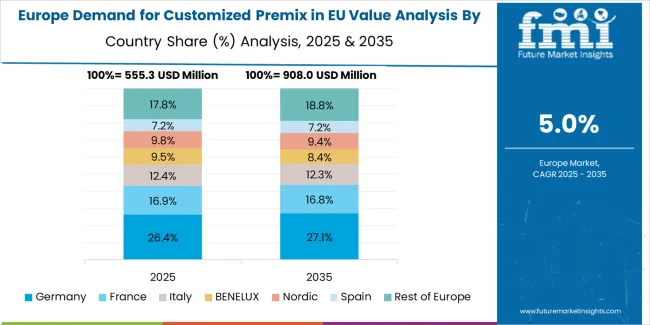
EU customized premix sales are projected to grow from USD 2,200.8 million in 2025 to USD 3,619.2 million by 2035, registering a CAGR of 5.1% over the forecast period. The Netherlands and Rest of Europe are expected to demonstrate the strongest growth trajectory with 5.7% and 5.6% CAGR respectively, supported by food technology innovation, supplement market expansion, and fortification regulatory frameworks. Germany follows with 5.3% CAGR, attributed to established food manufacturing infrastructure and health supplement consumption. France and Italy demonstrate 5.0% CAGR each, reflecting steady fortification adoption and dietary supplement growth. Spain shows 5.1% CAGR, aligned with EU average growth rates.
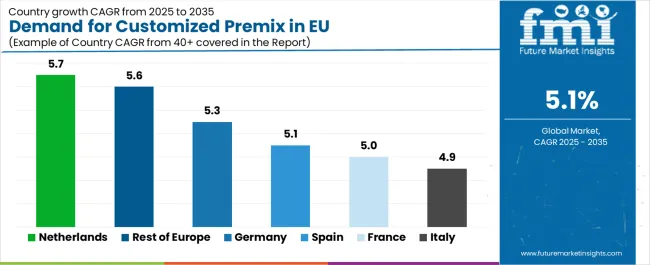
| Country | CAGR % (2025-2035) |
|---|---|
| Netherlands | 5.7% |
| Rest of Europe | 5.6% |
| Germany | 5.3% |
| Spain | 5.1% |
| France | 5.0% |
| Italy | 4.9% |
EU customized premix sales demonstrate solid growth across major European economies, with Netherlands leading expansion at 5.7% CAGR through 2035, driven by food technology innovation and personalized nutrition development. Rest of Europe shows 5.6% CAGR through diverse regional markets and expanding fortification adoption. Germany records 5.3% CAGR reflecting established food manufacturing and supplement sectors. Spain maintains 5.1% CAGR aligned with EU growth rates. France and Italy show 5.0% and 4.9% CAGR through steady health consciousness and fortification trends.
The customized premix industry in Germany is projected to exhibit steady growth with a CAGR of 5.3% through 2035, driven by exceptionally well-developed food processing capabilities, comprehensive dietary supplement industry, and strong pharmaceutical manufacturing presence throughout the country. Germany's sophisticated food technology sector and internationally recognized leadership in quality standards are creating substantial demand for diverse customized premix varieties across all manufacturing segments.
Major food manufacturers, supplement producers, and pharmaceutical companies systematically incorporate customized premix into product formulations, often dedicating extensive quality assurance resources to nutrient verification and positioning premix sourcing as critical to product quality. German demand benefits from high health consciousness, substantial food processing capacity supporting fortification adoption, and regulatory compliance focus that naturally supports customized premix utilization across professional manufacturing beyond basic fortification applications.
Growth drivers:
The customized premix industry in France is expanding at a steady CAGR of 5.0%, supported by evolving premium food product development, growing dietary supplement acceptance, and increasing fortification trends despite France's strong culinary traditions. France's sophisticated food culture and expanding health awareness are driving demand for quality customized premix across diverse food manufacturing applications.
Major food companies, supplement brands, and specialty food producers strategically establish comprehensive premix sourcing programs to serve continuously growing fortification requirements. French sales particularly benefit from premium product positioning demanding superior ingredient quality, driving innovation and natural ingredient development within the customized premix category. Health-focused product development initiatives and nutritionist recommendations significantly enhance adoption rates despite traditional preference for unfortified foods in French cuisine.
Success factors:
The customized premix industry in Italy is growing at a steady CAGR of 4.9%, fundamentally driven by increasing health consciousness, expanding dietary supplement market, and gradual modernization of Italian food manufacturing to incorporate fortification strategies. Italy's evolving health awareness and Mediterranean diet adaptation are gradually driving demand for customized premix as food manufacturers recognize nutritional enhancement opportunities and functional food positioning.
Major food processors, supplement companies, and functional food brands strategically invest in customized premix integration and fortification programs to address growing consumer interest in nutritional products. Italian sales particularly benefit from functional beverage applications, creating natural adoption among health-focused manufacturers, combined with dietary supplement growth in Milan, Rome, and other major cities contributing to expansion through wellness product development.
Development factors:
Demand for customized premix in Spain is projected to grow at a CAGR of 5.1%, aligned with EU average growth, substantially supported by food manufacturing sector modernization, expanding dietary supplement market, and increasing fortification awareness. Spanish food industry development and health consciousness trends position customized premix as aligned with manufacturing innovation and nutritional product growth.
Major food processors, supplement brands, and functional food companies systematically expand customized premix procurement and fortification strategies, with Spanish manufacturers proving particularly successful in developing fortified products through innovation initiatives and health positioning. Spain's growing wellness culture supports customized premix adoption among manufacturers seeking nutritional enhancement solutions and functional ingredient systems.
Growth enablers:
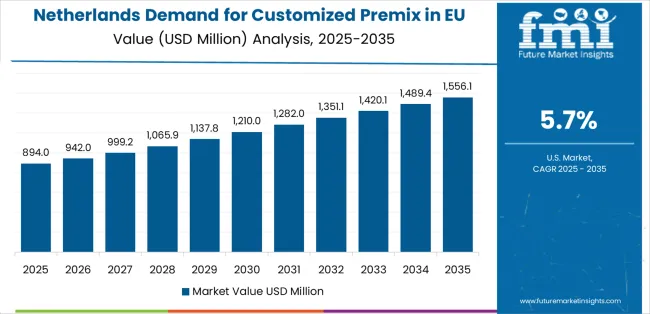
Demand for customized premix in the Netherlands is expanding at a leading CAGR of 5.7%, fundamentally driven by strong food technology innovation culture, advanced personalized nutrition sector, and comprehensive ingredient development capabilities supporting customized premix adoption across food manufacturing and supplement channels. Dutch food industry demonstrates particularly high receptivity to nutrition innovation and willingness to adopt advanced fortification solutions for product development and health positioning.
Netherlands sales significantly benefit from well-developed food science infrastructure, including personalized nutrition companies, advanced premix manufacturers, and innovative supplement brands testing new formulations in a progressive Dutch market environment. The country's nutrition innovation leadership includes DSM-Firmenich headquarters and specialized premix developers. The Netherlands also serves as innovation testing ground for European customized premix applications, with successful Dutch formulation development often expanding to broader European markets.
Innovation drivers:
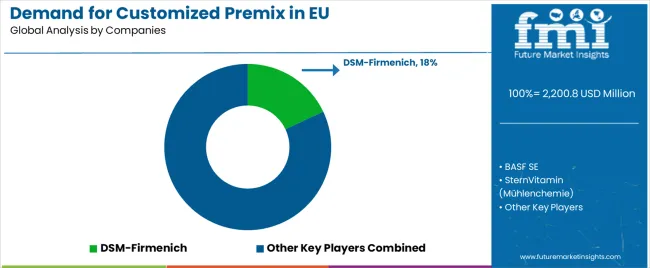
EU customized premix sales are defined by competition among specialized premix manufacturers, ingredient suppliers, and nutrition companies. Companies are investing in microencapsulation technologies, formulation optimization programs, regulatory expertise development, and clean-label ingredient sourcing to deliver high-quality, scientifically validated, and application-optimized customized premix solutions. Strategic partnerships with food manufacturers, supplement brands, and pharmaceutical companies, alongside technical service expansion initiatives and educational campaigns emphasizing formulation benefits and stability validation are central to strengthening competitive position.
Major participants include DSM-Firmenich with an estimated 18.0% share, leveraging its comprehensive nutrition expertise, Netherlands headquarters presence, and established European premix manufacturing capabilities through integrated vitamin production and formulation operations. DSM-Firmenich benefits from extensive food manufacturer relationships, technical micronutrient knowledge, and ability to position customized premix alongside vitamin ingredients and nutritional solutions, supporting integrated ingredient supply and technical service excellence.
BASF SE holds approximately 15.0% share, emphasizing pharmaceutical-grade premix manufacturing, strong German production infrastructure, and quality positioning across European food and pharmaceutical applications. BASF's success in developing high-quality premix solutions with stringent quality standards creates strong positioning and manufacturer acceptance, supported by technical capabilities and regulatory expertise.
SternVitamin (Mühlenchemie) accounts for roughly 6.0% share through its position as specialized German fortification expert with premix formulation focus, providing application-optimized solutions through technical-driven development. The company benefits from food manufacturer partnerships, fortification specialization, and comprehensive technical support helping customers optimize formulations, supporting application development positioning and customer service excellence.
Barentz International represents approximately 5.0% share, supporting growth through European distribution network, custom premix capabilities, and ingredient sourcing expertise across specialized applications. Barentz leverages distribution knowledge applied to premix solutions, technical service provision, and customization flexibility, attracting manufacturers seeking tailored fortification solutions with responsive service.
Other companies collectively hold 56.0% share, reflecting competitive dynamics within European customized premix sales, where numerous regional premix manufacturers, specialized fortification companies, contract manufacturers, and emerging clean-label suppliers serve specific application requirements, local operations, and specialized formulation needs. This competitive environment provides opportunities for differentiation through specialized formulations, organic certification, natural ingredient sourcing, and application-specific positioning resonating with food manufacturers seeking distinctive premix solutions.
| Item | Value |
|---|---|
| Quantitative Units | USD 3,619.2 million |
| Product Type | Premix Blends/D2C, Drum-to-Hopper |
| Application | Food Sector, Dietary Supplements, Pharma OTC Drugs, Pet Food |
| Distribution Channel | B2B (Manufacturers), Direct-to-Consumer |
| Nature | Conventional, Clean-label/Natural |
| Countries Covered | Germany, France, Italy, Spain, the Netherlands, and the Rest of Europe |
| Key Companies Profiled | DSM-Firmenich, BASF SE, SternVitamin, Barentz International, Specialized manufacturers |
| Additional Attributes | Dollar sales by product type, application, distribution channel, and nature; regional demand trends across major European economies; competitive landscape analysis with established premix manufacturers and specialized fortification companies; food manufacturer preferences for various premix formats and formulations; integration with microencapsulation technologies and nutrient delivery systems; innovations in clean-label formulation and natural ingredient sourcing; adoption across food processing, supplement, and pharmaceutical channels; regulatory framework analysis for fortification standards and health claim validation; supply chain strategies including micronutrient sourcing; and penetration analysis for food manufacturers, supplement brands, and personalized nutrition platforms across European markets. |
Product Type
The global demand for customized premix in EU is estimated to be valued at USD 2,200.8 million in 2025.
The market size for the demand for customized premix in EU is projected to reach USD 3,619.2 million by 2035.
The demand for customized premix in EU is expected to grow at a 5.1% CAGR between 2025 and 2035.
The key product types in demand for customized premix in EU are premix blends/d2c and drum-to-hopper.
In terms of application, food sector segment to command 45.0% share in the demand for customized premix in EU in 2025.






Our Research Products

The "Full Research Suite" delivers actionable market intel, deep dives on markets or technologies, so clients act faster, cut risk, and unlock growth.

The Leaderboard benchmarks and ranks top vendors, classifying them as Established Leaders, Leading Challengers, or Disruptors & Challengers.

Locates where complements amplify value and substitutes erode it, forecasting net impact by horizon

We deliver granular, decision-grade intel: market sizing, 5-year forecasts, pricing, adoption, usage, revenue, and operational KPIs—plus competitor tracking, regulation, and value chains—across 60 countries broadly.

Spot the shifts before they hit your P&L. We track inflection points, adoption curves, pricing moves, and ecosystem plays to show where demand is heading, why it is changing, and what to do next across high-growth markets and disruptive tech

Real-time reads of user behavior. We track shifting priorities, perceptions of today’s and next-gen services, and provider experience, then pace how fast tech moves from trial to adoption, blending buyer, consumer, and channel inputs with social signals (#WhySwitch, #UX).

Partner with our analyst team to build a custom report designed around your business priorities. From analysing market trends to assessing competitors or crafting bespoke datasets, we tailor insights to your needs.
Supplier Intelligence
Discovery & Profiling
Capacity & Footprint
Performance & Risk
Compliance & Governance
Commercial Readiness
Who Supplies Whom
Scorecards & Shortlists
Playbooks & Docs
Category Intelligence
Definition & Scope
Demand & Use Cases
Cost Drivers
Market Structure
Supply Chain Map
Trade & Policy
Operating Norms
Deliverables
Buyer Intelligence
Account Basics
Spend & Scope
Procurement Model
Vendor Requirements
Terms & Policies
Entry Strategy
Pain Points & Triggers
Outputs
Pricing Analysis
Benchmarks
Trends
Should-Cost
Indexation
Landed Cost
Commercial Terms
Deliverables
Brand Analysis
Positioning & Value Prop
Share & Presence
Customer Evidence
Go-to-Market
Digital & Reputation
Compliance & Trust
KPIs & Gaps
Outputs
Full Research Suite comprises of:
Market outlook & trends analysis
Interviews & case studies
Strategic recommendations
Vendor profiles & capabilities analysis
5-year forecasts
8 regions and 60+ country-level data splits
Market segment data splits
12 months of continuous data updates
DELIVERED AS:
PDF EXCEL ONLINE
Western Europe Customized Premix Market Analysis – Size, Share & Trends 2025 to 2035
Customized Premix Market Analysis - Size, Share, & Forecast Outlook 2025 to 2035
Comprehensive Analysis of Food Premix Market by Form, Ingredient Type, End-Use Application and Function Type through 2035
Korea Customized Premix Market Analysis – Size, Share & Trends 2025 to 2035
Demand and Trend Analysis of Customized Premix in Japan Size and Share Forecast Outlook 2025 to 2035
Europe Radiotherapy Patient Positioning Market Size and Share Forecast Outlook 2025 to 2035
Europe Polyvinyl Alcohol Industry Analysis Size and Share Forecast Outlook 2025 to 2035
Customized Skincare Market Size and Share Forecast Outlook 2025 to 2035
Premix Packaging Machine Market Size and Share Forecast Outlook 2025 to 2035
Europe Cruise Market Forecast and Outlook 2025 to 2035
Europium Market Forecast and Outlook 2025 to 2035
Eucommia Leaf Extract Market Size and Share Forecast Outlook 2025 to 2035
Europe Massage Therapy Service Market Size and Share Forecast Outlook 2025 to 2035
Europe Cement Market Analysis Size and Share Forecast Outlook 2025 to 2035
European Union Tourism Industry Size and Share Forecast Outlook 2025 to 2035
Europe Injection Molding Machines Market Size and Share Forecast Outlook 2025 to 2035
Europe Injection Moulders Market Size and Share Forecast Outlook 2025 to 2035
Europe and MENA Generic Oncology Drug Market Size and Share Forecast Outlook 2025 to 2035
Europe Masking Tapes Market Size and Share Forecast Outlook 2025 to 2035
Europe Liners Market Size and Share Forecast Outlook 2025 to 2035

Thank you!
You will receive an email from our Business Development Manager. Please be sure to check your SPAM/JUNK folder too.
Chat With
MaRIA